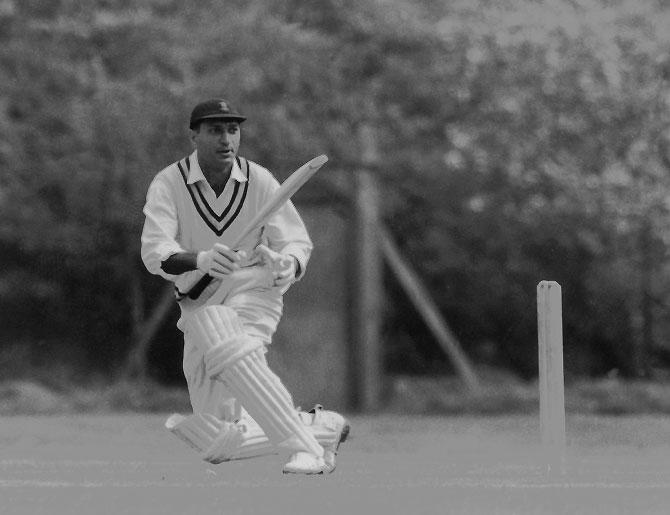Ahead of the four-Test series against the West Indies, which begins in Antigua on July 21, Rajneesh Gupta sheds light on India's first tour of the Caribbean islands.

A dominant force in the 1970s and 1980s, West Indies cricket has been on the decline for the last two decades, the performances of their Test teams both away and at home disappointing.
Since 2000, the Windies have won just 18 out of 71 Tests, compared to 66 victories in 162 Tests before that period.
With the Indian cricket team, led by Virat Kohli on its 11th Test tour of the Caribbean, it would be interesting to know about the team's maiden trip to the West Indies.
It all began in December 1952. As soon as the home series against Pakistan -- which the hosts won 2-1 -- concluded, the Indians left for their first-ever tour of the West Indies.
India became the first Test team other than England to tour the West Indies.
The selectors nominated Vijay Hazare as captain on November 24 and he was added to the selection panel. The tour party was announced on December 6.
Before the tour began, five of the selected players withdrew. Probir Sen, whose place was taken by Ebrahim Maka; C D Gopinath, who broke his collar bone and was replaced by L Adiseth, the burly doctor and mainstay of Mysore cricket, who also withdrew later; G Kasturirangan, who had a groin injury and was replaced by Kannayiram; Ghulam Ahmed, who turned down the tour in order to get married on December 26, three days after the team flew from India.
It was originally decided that 16 players, rather than 15, would be selected, but after Ahmed withdrew, the Board deferred its decision on naming the 16th player, as they were still hopeful of persuading Ahmed to tour.
The tour party:
Opening batsmen: Madhav Apte, Pankaj Roy.
Middle-order batsmen: Vijay Hazare (captain), Dattaji Gaekwad, C V Gadkari, Deepak Shodhan, Vijay Manjrekar, Polly Umrigar.
Wicketkeepers: Ebrahim Maka, Nana Joshi
All-rounders: Vinoo Mankad (vice-captain), G S Ramchand
Spinners: Subhash Gupte.
Fast bowlers: Dattu Phadkar, Kannayiram.

The team departed from Santa Cruz airport, Bombay, for Heathrow, London, on December 23 and spent a few days in the city during Christmas.
On December 28 they boarded the S S Golfito at Southampton, together with the West Indian players based in England.
It was a banana boat, a small cargo vessel that carried bananas from Barbados to the UK. Most of the Indian players felt unwell because of the high seas and rough weather.
On reaching Bridgetown on January 4 after a stormy crossing, Frank Worrell and Sonny Ramadhin disembarked and got a bigger welcome than the Indians, who sailed to Port of Spain, Trinidad, the following day.
Matches in those days were restricted to four centres: Trinidad, British Guyana (now Guyana), Barbados and Jamaica.
The Indians spent two, three weeks in each place during which they played a colony game and a Test.
Only Barbados, Jamaica and British Guyana had turf wickets. Trinidad had jute matting, on which India played the first and third Tests.
Barring a few players, most of the touring party had little experience of playing on matting, which was a completely different ball game as opposed to playing on turf.
Fortunately for the tourists, the West Indies had only one genuine quick bowler in Frank King.
The Indians did better than expected. Though they failed to register a victory over the West Indies, they lost only one Test, the other four being drawn. That was the only game on the tour in which the Indians were defeated.
Their solitary first-class success was against Jamaica.
The most impressive feature was the team's fielding, even though the catching was not always in the same class.
It was said that the 1952-1953 team, with C V Gadkari, Polly Umrigar, Dattaji Gaekwad, Madhav Apte and G S Ramchand in the ranks (Jayant Ghorpade who joined later was another excellent fielder), was the best Indian fielding side to visit the West Indies.
'The Indians were not the best bowling side in the world, but they arguably were the best fielding side,' the great Everton Weekes said about the team.
The crowds were larger than anticipated. Twice, the gates had to be closed in the first Test at Port of Spain, and the ground record was broken for one day when 22,000 spectators turned up.
Tour fixtures and results:
| Dates | Venue | Opposition | Result (for India) |
| January 10-11, 1953 | San Fernando | Trinidad East Indians # | Drawn |
| January 13-17, 1953 | Port of Spain | Trinidad | Drawn |
| January 21-28, 1953 | PORT OF SPAIN | WEST INDIES, First Test | DRAWN |
| January 31- Feb 5, 1953 | Bridgetown | Barbados | Drawn |
| February 7-12, 1953 | BRIDGETOWN | WEST INDIES, Second Test | LOST by 142 runs |
| February 19-25, 1953 | PORT OF SPAIN | WEST INDIES, Third Test | DRAWN |
| March 1-2, 1953 | Georgetown | British Guyana East Indians # | Won by 43 runs |
| Mar 4-8, 1953 | Georgetown | British Guyana | Drawn |
| March 11-17, 1953 | GEORGETOWN | WEST INDIES, Fourth Test | DRAWN |
| March 20-23, 1953 | Kingston | Jamaica | Won by 6 wickets |
| March 28-Apr 4, 1953 | KINGSTON | WEST INDIES, Fifth Test | DRAWN |
# not first-class

Subhash Gupte, a little leg-break and googly bowler, and Polly Umrigar, the hard-hitting batsman, were India's stars of the tour.
Gupte took 50 wickets (27 of them in the Test series), while the other Indian bowlers had a combined tally of 57 wickets.
What made Gupte so effective was his ability to deceive batsmen with his flight and bowl a good wrong 'un.
He was well-supported by Vinoo Mankad at the other end.
Umrigar scored centuries in the first and fifth Tests and topped the batting averages with 550 runs. He received good help from Madhav Apte, Vijay Manjrekar and Pankaj Roy.
If there was anything India lacked, it was strong and aggressive captaincy.
In G S Ramchand's words: 'Vijay Hazare was a great batsman and an unassuming person, but his personality did not infuse confidence in the side. There was no planning, no team meetings or discussion of tactics. He did everything in a mechanical fashion and had confidence in only two bowlers -- Gupte and Mankad.'
'There was no fixed batting order. There was no planning, no thought as to which bowler should bowl to which batsmen,' Ramchand added. 'Someone like Dattu Phadkar, the all-rounder, could have made a difference had he led the team. He had the courage, the will and the stomach to take chances and his body language reflected that.'

The Indians had a great chance to win the only Test they lost.
Set a target of 272, India were 54/2 at close of play on the fourth day. The two not out batsmen, Roy and Ramchand, had taken the score to 70 on the fifth day when slow left-arm bowler Alf Valentine dismissed Roy.
From there on, India collapsed to 129 all out, as Sonny Ramadhin exploited the cracks on the wicket with a mixture of off and leg spin for figures of 5/26 in 24.5 overs.
He was sorted out later in the series, and dropped for the final Test, though he and Valentine were the West Indies' main bowlers.
The West Indies was led by Jeff Stollmeyer. Weekes was in terrific form, like he had been in the 1948-1949 series. He scored 207 in the first Test, 161 in the third, and 109 in the fifth, averaging 102 in the five Tests.
Walcott also shone, but until the last Test -- when he scored 237 in the first innings -- Worrell was out of touch.
The West Indies possessed more variety and all-round strength in the attack, with Valentine's left-arm spin the most effective.
King, a fast-medium bowler, showed promise, although he used the bumper a little too often for it to be a surprise ball.

In January 1953, off-break bowler Ghulam Ahmed was requested to fly out to the West Indies and support Mankad and Gupte as the chief spinners. However, he declined, as his wedding had already been postponed once because of a relative's illness. Uncapped leg-spinner Jayasingh Ghorpade was flown to Bridgetown instead.
There were some injury concerns for the Indian team during the tour. Dattaji Gaekwad injured his shoulder fielding in the second Test and Ebrahim Maka had two bones in his left hand fractured while batting against fast bowler Frank King in the third Test.
Neither could play again on the tour and were flown home from Port of Spain after the third Test.
A farewell dinner, hosted by the Jamaican Cricket Board of Control on Saturday, April 4 at the Myrtle Bank Hotel in Kingston, brought the tour to a close.
Roy and Deepak Shodhan flew from Kingston on April 7 to England for a holiday. The other team members sailed on the S S Cavina from Port Antonio, Jamaica, on April 8.
Ghorpade had given Hazare, who suffered badly from seasickness, his return plane ticket and the skipper flew with the professional players (Mankad, Phadkar, Ramchand and Umrigar) to London on April 8. Three days, Hazare flew to India.











